brake fluid DODGE CHALLENGER 2012 3.G User Guide
[x] Cancel search | Manufacturer: DODGE, Model Year: 2012, Model line: CHALLENGER, Model: DODGE CHALLENGER 2012 3.GPages: 124, PDF Size: 4.99 MB
Page 88 of 124
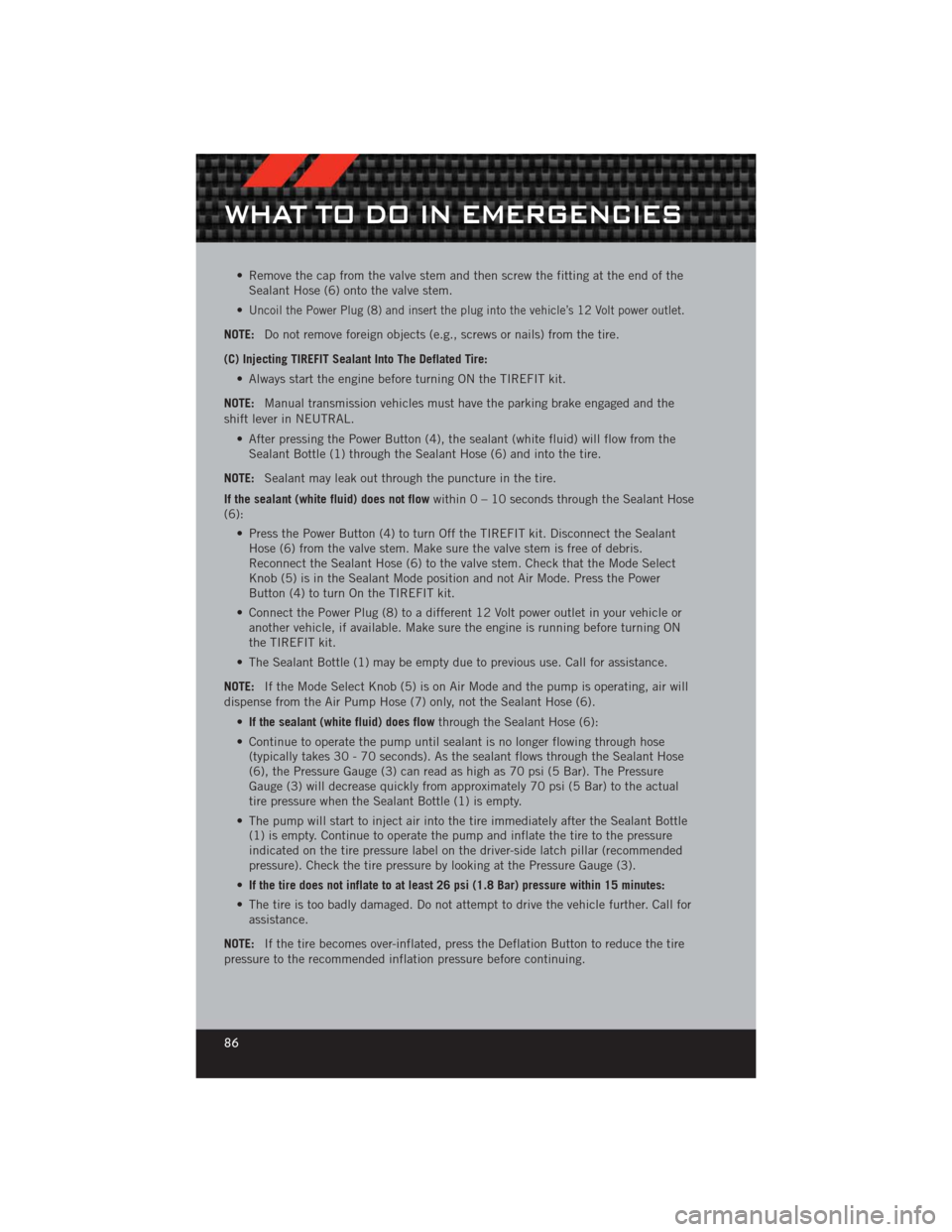
• Remove the cap from the valve stem and then screw the fitting at the end of theSealant Hose (6) onto the valve stem.
•
Uncoil the Power Plug (8) and insert the plug into the vehicle’s 12 Volt power outlet.
NOTE: Do not remove foreign objects (e.g., screws or nails) from the tire.
(C) Injecting TIREFIT Sealant Into The Deflated Tire: • Always start the engine before turning ON the TIREFIT kit.
NOTE: Manual transmission vehicles must have the parking brake engaged and the
shift lever in NEUTRAL.
• After pressing the Power Button (4), the sealant (white fluid) will flow from theSealant Bottle (1) through the Sealant Hose (6) and into the tire.
NOTE: Sealant may leak out through the puncture in the tire.
If the sealant (white fluid) does not flow within0–10seconds through the Sealant Hose
(6):
• Press the Power Button (4) to turn Off the TIREFIT kit. Disconnect the SealantHose (6) from the valve stem. Make sure the valve stem is free of debris.
Reconnect the Sealant Hose (6) to the valve stem. Check that the Mode Select
Knob (5) is in the Sealant Mode position and not Air Mode. Press the Power
Button (4) to turn On the TIREFIT kit.
• Connect the Power Plug (8) to a different 12 Volt power outlet in your vehicle or another vehicle, if available. Make sure the engine is running before turning ON
the TIREFIT kit.
• The Sealant Bottle (1) may be empty due to previous use. Call for assistance.
NOTE: If the Mode Select Knob (5) is on Air Mode and the pump is operating, air will
dispense from the Air Pump Hose (7) only, not the Sealant Hose (6).
•If the sealant (white fluid) does flow through the Sealant Hose (6):
• Continue to operate the pump until sealant is no longer flowing through hose (typically takes 30 - 70 seconds). As the sealant flows through the Sealant Hose
(6), the Pressure Gauge (3) can read as high as 70 psi (5 Bar). The Pressure
Gauge (3) will decrease quickly from approximately 70 psi (5 Bar) to the actual
tire pressure when the Sealant Bottle (1) is empty.
• The pump will start to inject air into the tire immediately after the Sealant Bottle (1) is empty. Continue to operate the pump and inflate the tire to the pressure
indicated on the tire pressure label on the driver-side latch pillar (recommended
pressure). Check the tire pressure by looking at the Pressure Gauge (3).
• If the tire does not inflate to at least 26 psi (1.8 Bar) pressure within 15 minutes:
• The tire is too badly damaged. Do not attempt to drive the vehicle further. Call for assistance.
NOTE: If the tire becomes over-inflated, press the Deflation Button to reduce the tire
pressure to the recommended inflation pressure before continuing.
WHAT TO DO IN EMERGENCIES
86
Page 102 of 124
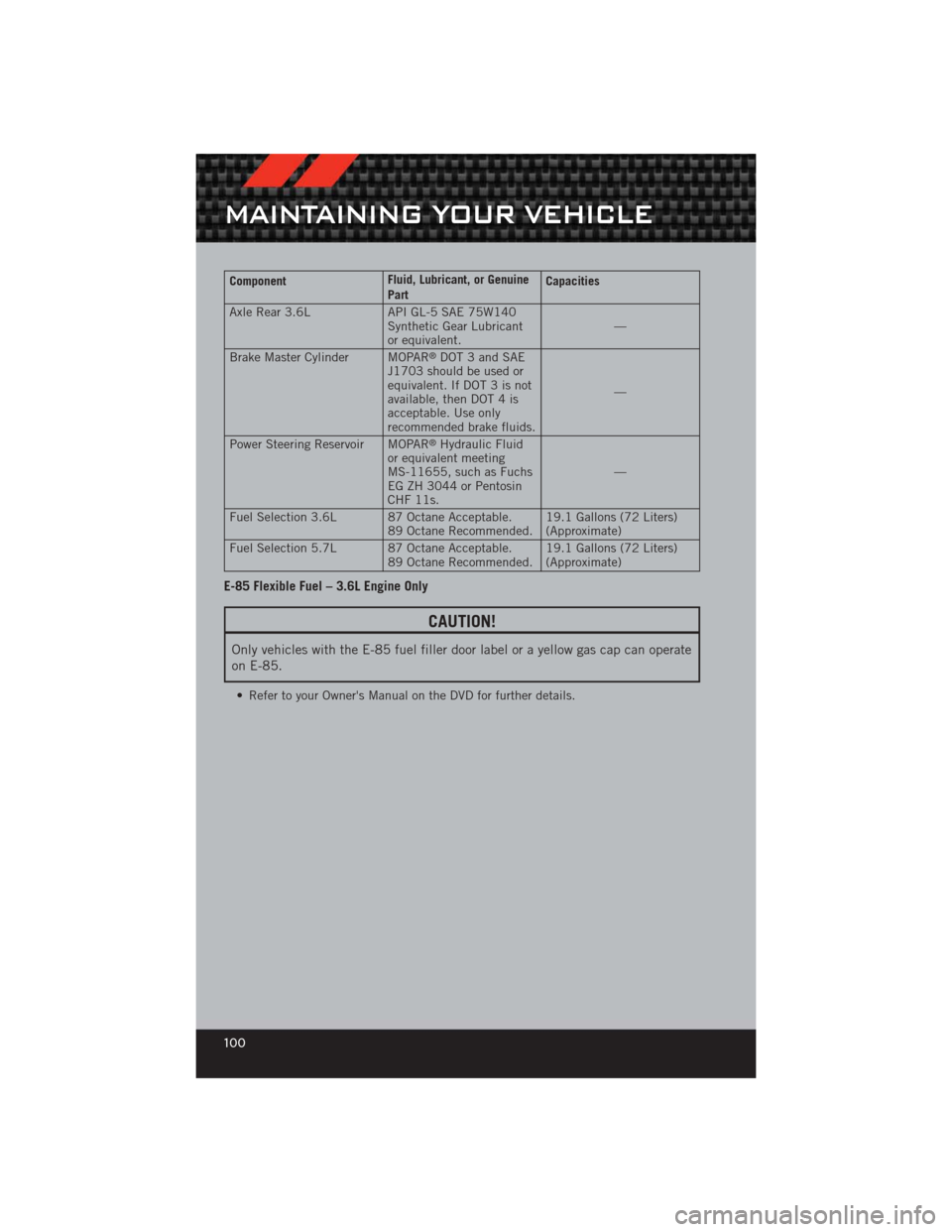
ComponentFluid, Lubricant, or Genuine
PartCapacities
Axle Rear 3.6L API GL-5 SAE 75W140 Synthetic Gear Lubricant
or equivalent. —
Brake Master Cylinder MOPAR
®DOT 3 and SAE
J1703 should be used or
equivalent. If DOT 3 is not
available, then DOT 4 is
acceptable. Use only
recommended brake fluids. —
Power Steering Reservoir MOPAR
®Hydraulic Fluid
or equivalent meeting
MS-11655, such as Fuchs
EG ZH 3044 or Pentosin
CHF 11s. —
Fuel Selection 3.6L 87 Octane Acceptable. 89 Octane Recommended.19.1 Gallons (72 Liters)
(Approximate)
Fuel Selection 5.7L 87 Octane Acceptable. 89 Octane Recommended.19.1 Gallons (72 Liters)
(Approximate)
E-85 Flexible Fuel – 3.6L Engine Only
CAUTION!
Only vehicles with the E-85 fuel filler door label or a yellow gas cap can operate
on E-85.
• Refer to your Owner's Manual on the DVD for further details.
MAINTAINING YOUR VEHICLE
100
Page 104 of 124
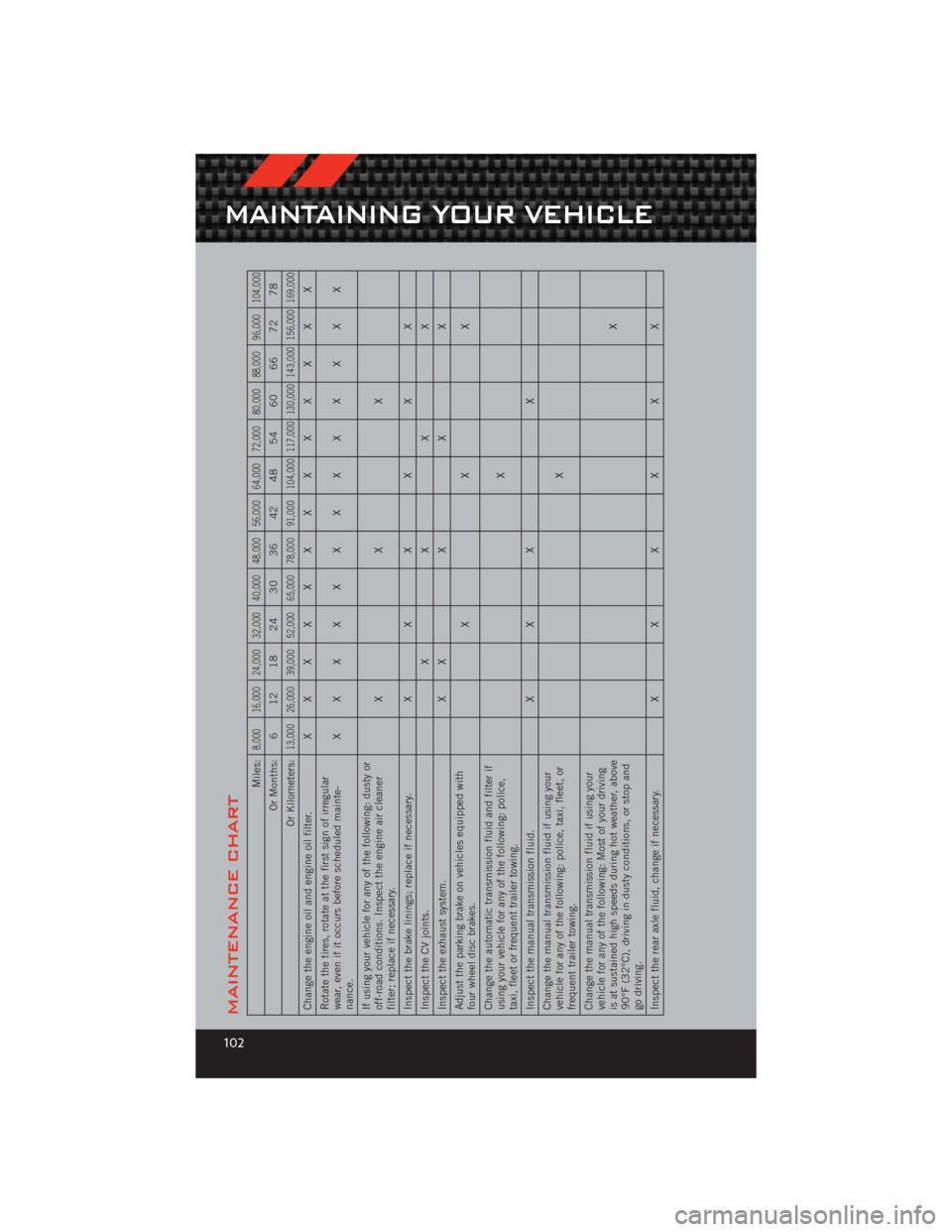
MAINTENANCE CHART
Miles:
8,000 16,000 24,000 32,000 40,000 48,000 56,000 64,000 72,000 80,000 88,000 96,000 104,000
Or Months: 6 12 18 24 30 36 42 48 54 60 66 72 78
Or Kilometers:
13,000 26,000 39,000 52,000 65,000 78,000 91,000 104,000 117,000 130,000 143,000 156,000 169,000
Change the engine oil and engine oil filter. XXXXXXXXXXXXX
Rotate the tires, rotate at the first sign of irregular
wear, even if it occurs before scheduled mainte-
nance. XXXXXXXXXXXXX
If using your vehicle for any of the following: dusty or
off-road conditions. Inspect the engine air cleaner
filter; replace if necessary. XXX
Inspect the brake linings; replace if necessary. X X XXXX
Inspect the CV joints. XXXX
Inspect the exhaust system. X XXXX
Adjust the parking brake on vehicles equipped with
four wheel disc brakes. XXX
Change the automatic transmission fluid and filter if
using your vehicle for any of the following: police,
taxi, fleet or frequent trailer towing. X
Inspect the manual transmission fluid. X X X X
Change the manual transmission fluid if using your
vehicle for any of the following: police, taxi, fleet, or
frequent trailer towing. X
Change the manual transmission fluid if using your
vehicle for any of the following: Most of your driving
is at sustained high speeds during hot weather, above
90°F (32°C), driving in dusty conditions, or stop and
go driving. X
Inspect the rear axle fluid, change if necessary. X X XXXX
MAINTAINING YOUR VEHICLE
102
Page 107 of 124
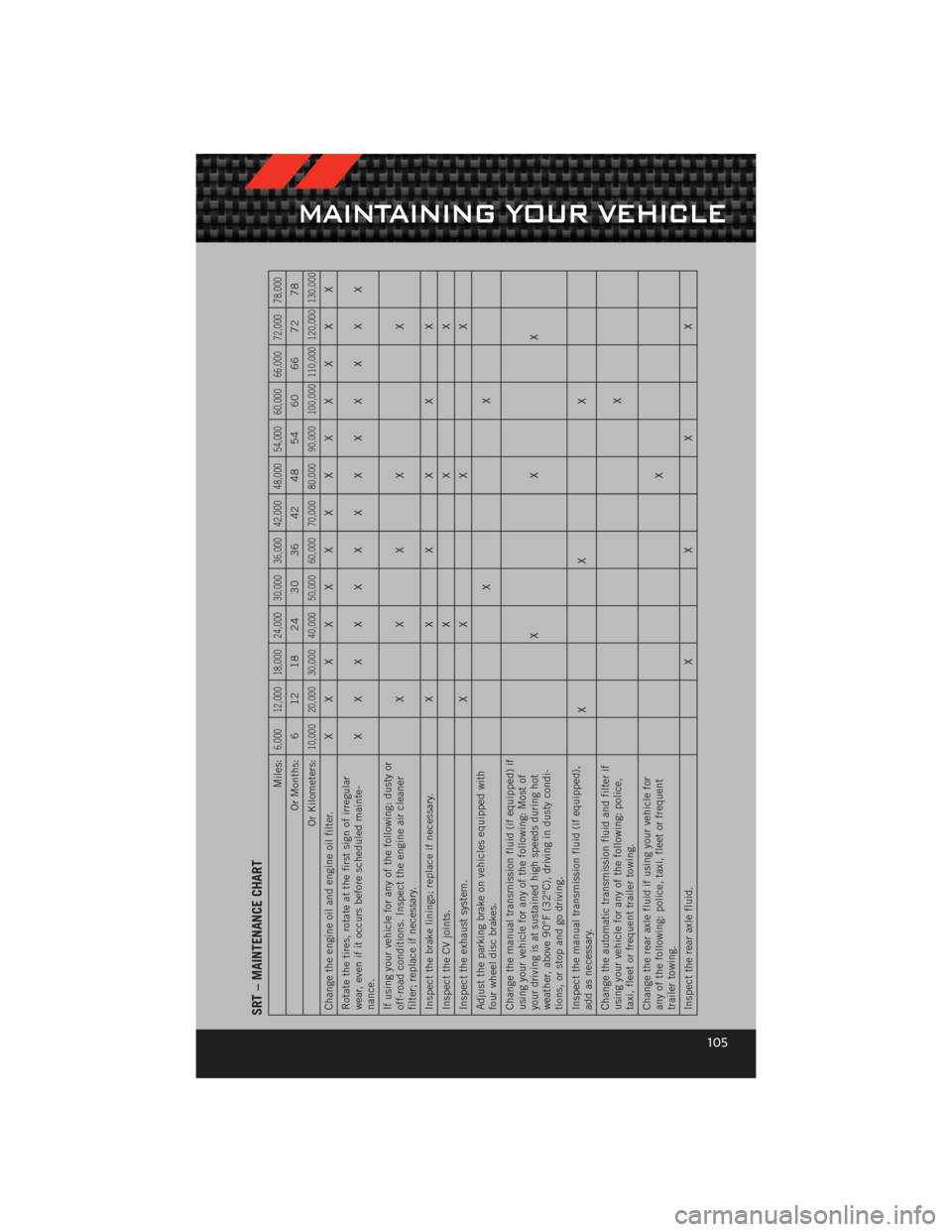
SRT – MAINTENANCE CHART
Miles:
6,000 12,000 18,000 24,000 30,000 36,000 42,000 48,000 54,000 60,000 66,000 72,000 78,000
Or Months: 6 12 18 24 30 36 42 48 54 60 66 72 78
Or Kilometers:
10,000 20,000 30,000 40,000 50,000 60,000 70,000 80,000 90,000 100,000 110,000 120,000 130,000
Change the engine oil and engine oil filter. XXXXXXXXXXXXX
Rotate the tires, rotate at the first sign of irregular
wear, even if it occurs before scheduled mainte-
nance. XXXXXXXXXXXXX
If using your vehicle for any of the following: dusty or
off-road conditions. Inspect the engine air cleaner
filter; replace if necessary. XXXX X
Inspect the brake linings; replace if necessary. X X XXXX
Inspect the CV joints. X X X
Inspect the exhaust system. X X X X
Adjust the parking brake on vehicles equipped with
four wheel disc brakes. XX
Change the manual transmission fluid (if equipped) if
using your vehicle for any of the following: Most of
your driving is at sustained high speeds during hot
weather, above 90°F (32°C), driving in dusty condi-
tions, or stop and go driving. XXX
Inspect the manual transmission fluid (if equipped),
add as necessary. XX X
Change the automatic transmission fluid and filter if
using your vehicle for any of the following: police,
taxi, fleet or frequent trailer towing. X
Change the rear axle fluid if using your vehicle for
any of the following: police, taxi, fleet or frequent
trailer towing. X
Inspect the rear axle fluid. XXXX
MAINTAINING YOUR VEHICLE
105
Page 110 of 124
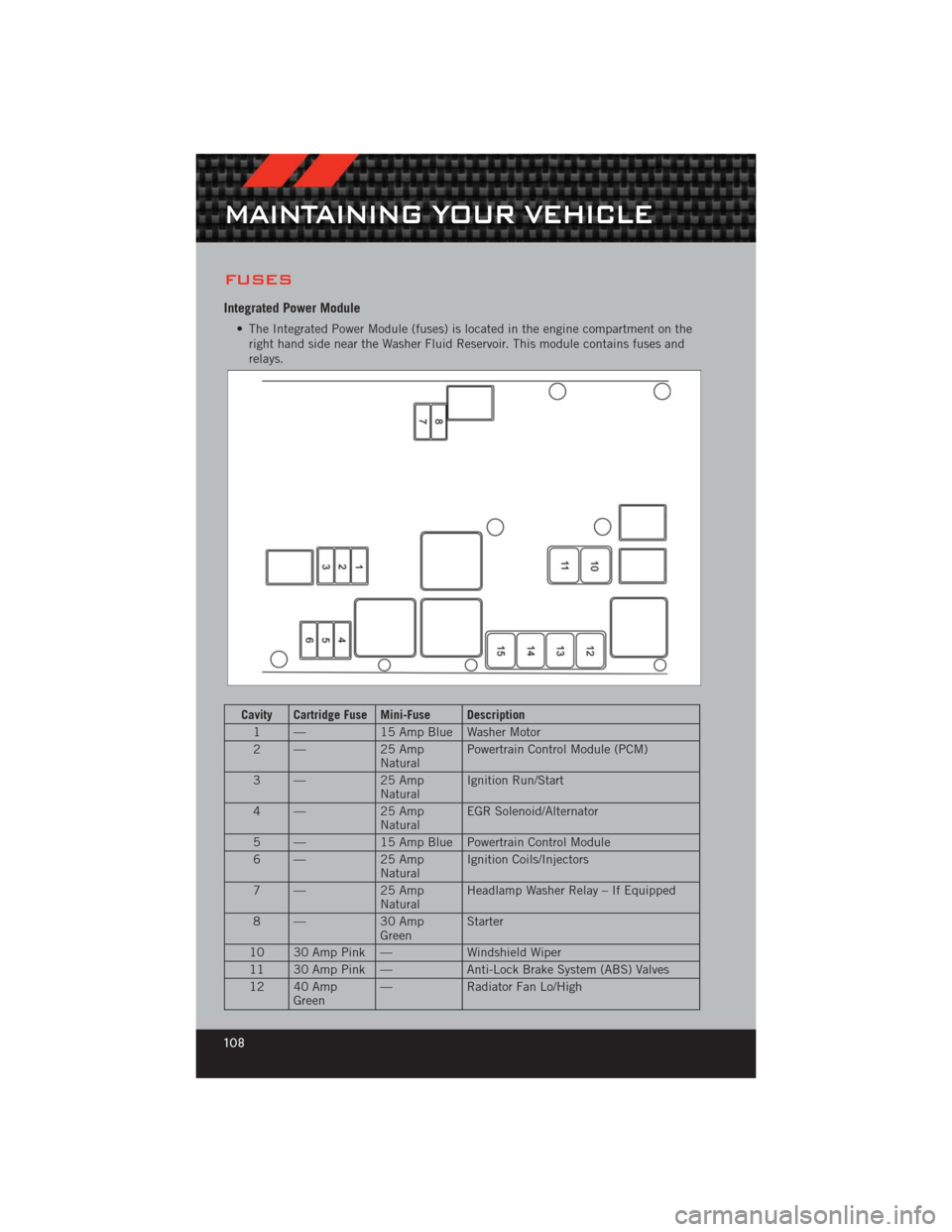
FUSES
Integrated Power Module
• The Integrated Power Module (fuses) is located in the engine compartment on theright hand side near the Washer Fluid Reservoir. This module contains fuses and
relays.
Cavity Cartridge Fuse Mini-Fuse Description
1 — 15 Amp Blue Washer Motor
2 — 25 Amp
Natural Powertrain Control Module (PCM)
3 — 25 Amp
Natural Ignition Run/Start
4 — 25 Amp
Natural EGR Solenoid/Alternator
5 — 15 Amp Blue Powertrain Control Module
6 — 25 Amp
Natural Ignition Coils/Injectors
7 — 25 Amp
Natural Headlamp Washer Relay – If Equipped
8 — 30 Amp
Green Starter
10 30 Amp Pink — Windshield Wiper
11 30 Amp Pink — Anti-Lock Brake System (ABS) Valves
12 40 Amp Green —
Radiator Fan Lo/High
MAINTAINING YOUR VEHICLE
108
Page 118 of 124
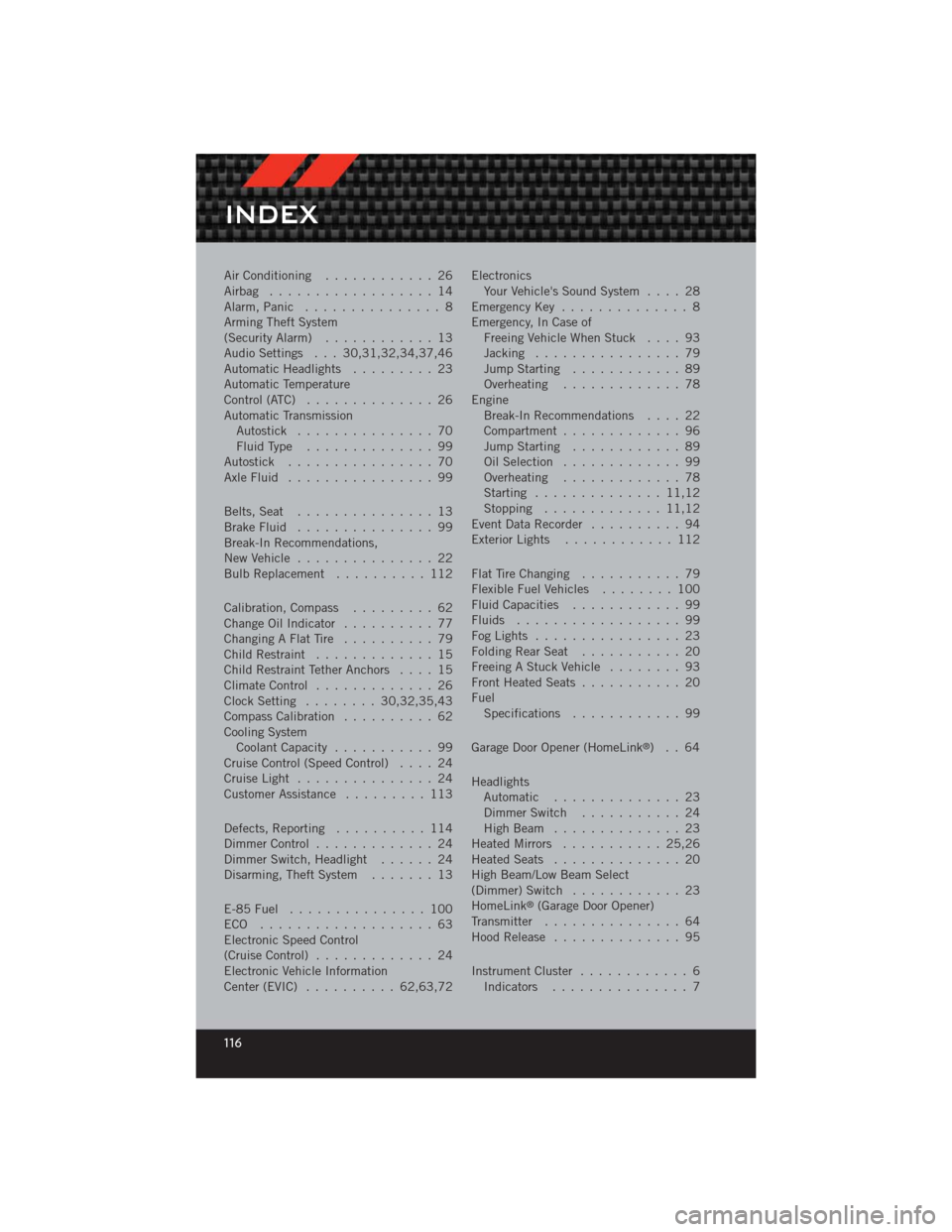
Air Conditioning............ 26
Airbag .................. 14
Alarm, Panic ............... 8
Arming Theft System
(Security Alarm) ............ 13
Audio Settings . . . 30,31,32,34,37,46
Automatic Headlights ......... 23
Automatic Temperature
Control (ATC) .............. 26
Automatic Transmission Autostick ............... 70
FluidType .............. 99
Autostick ................ 70
AxleFluid ................ 99
Belts, Seat ............... 13
BrakeFluid ............... 99
Break-In Recommendations,
New Vehicle ............... 22
Bulb Replacement .......... 112
Calibration, Compass ......... 62
Change Oil Indicator .......... 77
Changing A Flat Tire .......... 79
Child Restraint ............. 15
Child Restraint Tether Anchors .... 15
ClimateControl ............. 26
Clock Setting ........ 30,32,35,43
Compass Calibration .......... 62
Cooling System Coolant Capacity ........... 99
Cruise Control (Speed Control) .... 24
CruiseLight ............... 24
Customer Assistance ......... 113
Defects, Reporting .......... 114
Dimmer Control ............. 24
Dimmer Switch, Headlight ...... 24
Disarming, Theft System ....... 13
E-85 Fuel ............... 100
ECO ................... 63
Electronic Speed Control
(Cruise Control) ............. 24
Electronic Vehicle Information
Center(EVIC) .......... 62,63,72 Electronics
Your Vehicle's Sound System .... 28
Emergency Key .............. 8
Emergency, In Case of Freeing Vehicle When Stuck .... 93
Jacking ................ 79
Jump Starting ............ 89
Overheating ............. 78
Engine Break-In Recommendations .... 22
Compartment ............. 96
Jump Starting ............ 89
Oil Selection ............. 99
Overheating ............. 78
Starting .............. 11,12
Stopping ............. 11,12
EventDataRecorder .......... 94
Exterior Lights ............ 112
FlatTireChanging ........... 79
Flexible Fuel Vehicles ........ 100
Fluid Capacities ............ 99
Fluids .................. 99
FogLights ................ 23
FoldingRearSeat ........... 20
Freeing A Stuck Vehicle ........ 93
Front Heated Seats ........... 20
Fuel Specifications ............ 99
Garage Door Opener (HomeLink
®)..64
Headlights Automatic .............. 23
Dimmer Switch ........... 24
HighBeam .............. 23
Heated Mirrors ........... 25,26
Heated Seats .............. 20
High Beam/Low Beam Select
(Dimmer) Switch ............ 23
HomeLink
®(Garage Door Opener)
Transmitter ............... 64
Hood Release .............. 95
InstrumentCluster ............ 6 Indicators ............... 7
INDEX
116